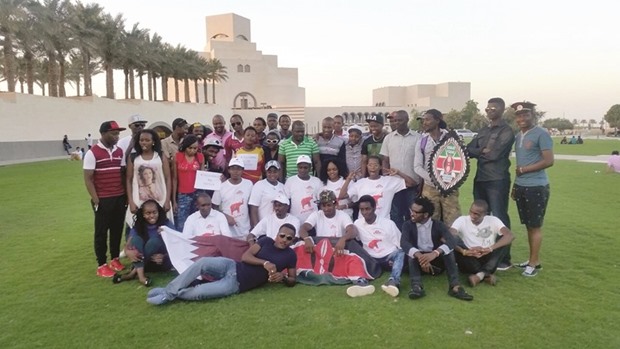The name tells the whole story. On Mashujaa Day -- Mashujaa is Swahili for Heroes -- Kenyans around the world celebrate the valour of their forefathers who fought for Kenya’s independence and also the bravery of those whose courageous actions made Kenya proud. In Qatar, members of the Kenyan community gathered and bonded over ways and means to follow in the footsteps of the “heroes” who fought for the well-being of their country.
A national holiday in Kenya, the Heroes’ Day annually falls on October 20. Until six years ago, this day was known as Kenyatta Day, in honour of Kenya’s first president, Jomo Kenyatta. However, after the promulgation of the new constitution in 2010, the name was changed to Mashujaa Day, or Heroes’ Day, so as to broaden the essence of this day by honouring not only the heroes of the Kenyan independence movement but all of Kenyan heroes.
Zacchaeus Njuguna of the Green Maasai Troupe, a group of good Samaritan Kenyan expats who are regularly involved in social work and charity events, told Community, “More than 50 Kenyan expats gathered at the Museum of Islamic Art Park on Friday. We started our programme with prayers and our national anthem.
“We soon got into an open discussion about the many heroes of Kenya, from Jomo Kenyatta to environmentalist Wangari Maathai. We shared what we had learnt from the heroes of Kenya and what we, as young and able people of Kenya, can do to translate their vision and work into action. We even discussed the speech made by the president of Kenya and heard each other out.”
The Green Maasai Troupe vowed to continue its good work that it believes helps in portraying a favourable image of its country here in Qatar. With Kenya’s Cabinet Secretary of Tourism Najib Balala flagging off a new drive #YallaKenya campaign to attract tourists from Qatar and the region to Kenya, earlier this month, Njuguna feels the community can only gain from this initiative. “I feel we need to take advantage of Kenya’s vast tourism potential. Yalla Kenya speaks of the great number of attractions that Kenya can offer to tourists,” Njuguna said.
“Later, after completing a quick tour of the Museum, we booked a big dhow and went on a two-hour trip. On board, we enjoyed singing, dancing and celebrating to our traditional songs. It was good fun.”
Of the many Kenyan heroes, Njuguna and his group is deeply inspired by Wangari Maathai – Kenyan environmentalist, founder of the Green Belt Movement (GBM), and the first African woman to receive the Nobel Peace Prize.
A couple of years ago, to mark her death anniversary, Njuguna and other Kenyans in Mesaieed planted trees to continue her legacy. Njuguna, a member of GBM which has planted more than 51mn trees in Kenya, had initiated the tree-planting drive at Mesaieed.
“Maathai had said that if we continue destroying our environment, nature will never forgive us. Be it climate change, soil erosion, pollution, or global warming, I have seen that happen. We are the ones causing it. But I try to show people that we are also the ones who have the solution,” Njuguna said.
The origins of Mashujaa Day can be traced to the arrest of Kenyatta and five other leaders of the Kenyan independence movement by the British colonial government on October 20, 1952. These “heroes” were part of the national movement, Mau Mau, which started in 1948, and are affectionately remembered as the ‘Kapenguria Six’ based on the detainment centre where they were kept.
The uprising by Mau Mau in 1952 led to the declaration of the state of emergency in Kenya. While the emergency was lifted in 1960, Dedan Kimathi, the leader of the group, had been arrested and killed in 1956. In 1963, Kenya became independent and the leaders of Mau Mau became national heroes.

A NATION REMEMBERS: On the occasion of Independence Day, Kenyan expats discussed the many national heroes, from Jomo Kenyatta to environmentalist Wangari Maathai.


